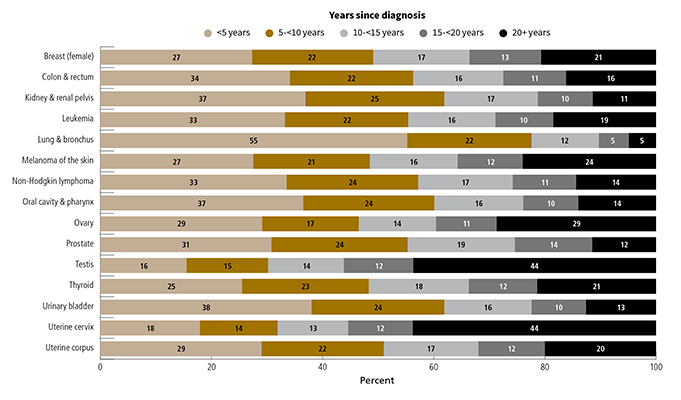Cancer Survivors Need More Access to Equitable Care
The number of people living after a cancer diagnosis keeps rising, naturally due to population growth and aging, plus better treatment and early detection.

This graphic shows a snapshot of cancer survivors living in the United States as of January 1, 2022, by their type of cancer and how long it's been since their diagnosis. The gray and black sections combined show the percentage of people who were diagnosed 10 or more years ago. As you can see, more than 50% of survivors of cancer of the breast (female), ovary, testis, thyroid, or cervix, as well as melanoma (skin), were diagnosed 10 or more years ago.
Every 3 years, researchers from the American Cancer Society (ACS) and the National Cancer Institute (NCI) publish their study about cancer treatment and survivorship statistics in the ACS journal CA: A Cancer Journal for Clinicians and also present their findings in an updated edition of the consumer-friendly report Cancer Treatment & Survivorship Facts & Figures. The focus of their work is to:
- Estimate the overall number of cancer survivors living in the US in the current year.
- Estimate the number of people who have survived the most common types of cancer by sex and race.
- Examine contemporary treatment patterns for the most common cancers by race/ethnicity.
The goal is to provide public health experts with an understanding of the growing need to improve “survivorship care” – the full range of health care after a cancer diagnosis through ongoing follow-up care.
They found that the number of people living in the United States with a history of a cancer diagnosis – commonly known as cancer survivors – continues to increase. In January 2022, their numbers reached just over 18 million. The number of survivors naturally increases partly because of overall population increases and specifically because the number of people age 65 and older (who have the highest risk for cancer) increases. But more people are also surviving because of improvements in early cancer detection and treatment.
“It’s important to recognize that not all people living with a history of cancer identify with the term “cancer survivor,” although the data we used included them.
“Another key point is that these estimates don’t distinguish between people receiving treatment, those living with cancer as a chronic disease, and those living cancer free.”
– Kim Miller, MPH, ACS scientist and lead study author
The researchers also learned that:
- More than half of those survivors were diagnosed within the past 10 years, and more than 18% were diagnosed more than 20 years ago.
- About 2 out 3 cancer survivors are age 65 or older, while less than 1 in 10 are younger than age 50.
Breast cancer is the most prevalent cancer among women.
More than 4 million women in the US have a history of a breast cancer diagnosis. The next two most prevalent cancers (those with the highest number of survivors) among women are endometrial (uterine corpus) and thyroid cancers.
Prostate cancer is the most prevalent cancer among men.
Over 3.5 million men in the US have a history of a prostate cancer diagnosis. The next two most prevalent cancers among men are melanoma of the skin and colorectal cancer.
“As the population of cancer survivors continues to grow and age, there’s an increased need for better delivery and coordination of post-treatment cancer care between cancer providers and primary care physicians to limit late and long-term effects of cancer and its treatment,” says Kim Miller, MPH, ACS scientist and lead author of the study.
“Plus, there are still knowledge gaps about the needs of cancer survivors and a lack of strong evidence-based guidelines and best practices for equitable delivery of rehabilitation, post-treatment cancer care, as well as quality primary treatment,” Miller adds.
Black people continue to have lower survival rates than White people for most types of cancer.
Black people are less likely to have cancer diagnosed when it’s at an early stage, when treatment is usually less complicated.
- For women diagnosed with stage I breast cancer, the 5-year relative survival rate approaches 100%. About 68% of White women in 2018 were diagnosed with stage I breast cancer, compared to 53% of Black women.
- Similarly, for endometrial cancer, about 73% of White women were diagnosed with stage I disease in 2018, compared to 59% of Black women.
Even when researchers account for differences in the cancer stage at diagnosis, 5-year relative survival is lower for most cancers in Black people compared with White people.
A large reason that Black people with cancer are diagnosed at a later stage and don't survive as long is because, as a whole, they have for less access to cancer care. Health insurance coverage is a key barrier to accessible care. Black people are more likely than White people to have health insurance with inadequate coverage (underinsured) or no health insurance at all.
“Our estimates don’t reflect the affect of the COVID-19 pandemic on cancer survival because our data was only through 2018, before the pandemic started.”
– Kim Miller, MPH, ACS scientist and lead study author
Some of the largest racial disparities in treatment are for rectal and lung cancers.
Only 41% of Black people with stage I rectal cancer receive surgical treatment (proctectomy or proctocolectomy) compared to 66% of White people. Similarly, 55% of White patients diagnosed with stage I non-small cell lung cancer (the most common type of lung cancer) receive surgical treatment, compared to only 49% of Black patients.
“This is the first time we’ve presented treatment data by race and ethnicity for some of the most common types of cancer,” says Miller. “The survivor population is increasingly diverse, and our study illuminates the need for public health experts to build and strengthen resources to improve equitable access to survivorship care and reduce disparities for communities of color.”
The ACS prioritizes survivorship research and support.
Survivors sometimes have side effects that last several years or may occur many years after treatment has ended. In addition, survivors often face many challenges in navigating the health care system and obtaining recommended long-term survivorship care. Further, as the number of cancer survivors continues to grow, so too does the number of informal caregivers in the US. As such, the ACS has a growing number of survivorship tools to help patients, caregivers, and health care providers.
For more resources see Survivorship: During and After Treatment and Tools for Cancer Survivors and Caregivers and Tools for Health Care Professionals on page 30 of Cancer Treatment & Survivorship Facts & Figures 2022-2024.




